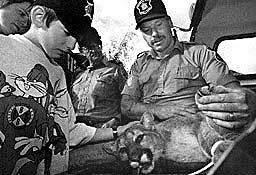
A tightly-composed image with all elements in the right places, including Bugs Bunny's eyes on the boy's shirt. They seem to be warily checking out the sedated cougar.
Composition, the act of composing the image in the viewfinder, is a visual process of organizing the elements and individual details of a scene into a balanced and pleasing arrangement. Because what one person finds pleasing, someone else will not, composition is largely a matter of personal taste.
In this section, we take that into account. There is no right or wrong composition in photography. A composition that conveys a photographer's intended meaning is an effective one. A composition that doesn't or that confuses the viewer is not.
A photograph that communicates its message - that says what you want it to say, says it clearly, and that interests its viewer - is an effecive composition.
How you arrange a scene's elements in your camera's viewfinder will not only determine the effectiveness of your picture's graphic design, but will also contribute to how well its message is conveyed. There is more to good composition, though, than the placement of elements. Lighting, shutter speed, depth of field and other considerations contribute to a picture's mood and clarity of what the picture is saying, and therefore the effectiveness of its composition.
TREAT THE RULES OF COMPOSITION AS GUIDELINES
Some of the so-called "rules" of composition presented here should be considered as guidelines. They are based on recreating similarities in the make-up of many different images that many people have found to be esthetically-pleasing. We do not intend that a rule of composition or a design concept be taken as a hard and fast rule that must be observed. Besides, some renowned photographs violate all the rules of composition and are still excellent pictures. This doesn't mean that the rules are without value. They are tremendously valuable. They are time-proven, and provide great guidelines for photographers at any level. We use them all the time.
ORIGIN OF THE RULES OF COMPOSITION
Years ago, artists who had been born with an innate sense of design created works that were perceived, by other skilled artists, as having good composition. Not only that, but their works were very popular with the general public and art afficionados. Analysis of such works showed patterns and trends in the organization and inter-relationships of lines, shapes, forms and colors that were recognized as contributing to the effectiveness of the works. It was found that others could employ these patterns as techniques in improving their own works. When they were defined, they became known as the rules of composition.
FOLLOW THE RULES UNTIL YOU KNOW WHEN TO BREAK THEM
We hope in this section to help everyone to compose better pictures, but especially the person who has no idea of composition - the photographer for whom taking a picture means just picking up a camera to point it and shoot it with little thought for the arrangement of the elements in a scene. Such a person would rarely be pleased with the results of his or her normal photography, and could benefit enormously from an understanding of the elements of composition.
Anyone who has an interest in improving their pictures would do well to go through this section and use the tips and hints it contains in their photography to see if their pictures improve.
By religiously observing the principles of composition, they will become firmly cemented in your mind. Employing them will become second nature to you. If you don’t find there is an improvement in your pictures and people aren’t commenting on how great they look, we will be greatly surprised.
Once you have the rules of composition down pat, experiment and break a rule here or there when you feel the image will work better without it. That’s called individual style, and the creativity that stems from it produces some great images. The point is that you will know when to break a rule of composition once you know what the rules are and how they work.
Sumber: PhotograpyTips.Com












